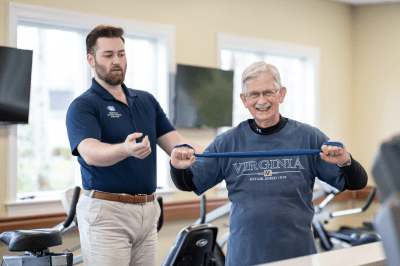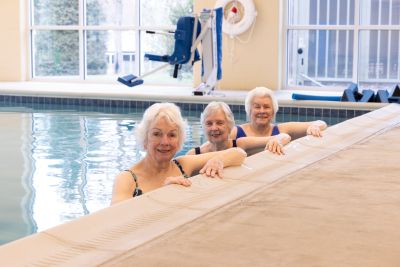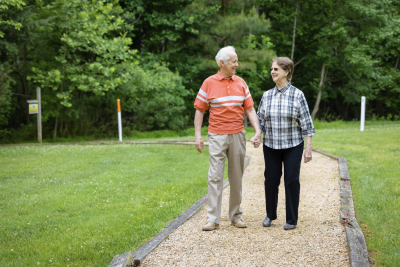As we age, staying active and preventing falls become increasingly important for maintaining our health, safety, and independence. September is Fall Prevention Awareness Month (sometimes shortened to Fall Prevention Month), and September 30 through October 6, 2024, is Active Aging Week. Here are some strategies for fall prevention and tips to stay active to help seniors live healthier, safer lives.
Understanding Fall Risks
Falls are a leading cause of injury among older adults, often resulting in fractures, a decline in independence, and a fear of falling again. Factors that can cause or contribute to falls include muscle weakness, poor balance, certain medications, vision and hearing problems, and environmental hazards. Recognizing these risks is the first step toward fall prevention in seniors.
How to Prevent Falls at Home
The CDC fall prevention guidelines and those from other health authorities offer excellent advice that address the main factors behind loss of coordination.
Home Safety Modifications
Creating a safer home environment is essential to preventing falls among seniors. Many falls occur because of common household hazards that can be easily mitigated with a few adjustments, such as:
- Removing tripping hazards. Minimize clutter, secure loose rugs, and ensure pathways are clear.
- Installing safety equipment. Install any needed safety equipment, such as grab bars (near toilets and in showers or tubs), raised toilet seats, staircase handrails, and nonslip mats.
- Improving lighting. Ensure all areas, especially stairways and hallways, are well lit.
- Rearranging furniture. Arrange furniture to create clear, unobstructed paths for walking, and ensure there is adequate space between furniture items.
- Managing cords and wires. Keep electrical cords and wires out of high-traffic areas, or secure them along walls.
 Balance and Strength Exercises
Balance and Strength Exercises
Regular physical activity, particularly exercises that improve balance and strength, can help prevent falls. Consider prioritizing activities such as Tai Chi, yoga, and specific balance exercises.
Appropriate Footwear
Wearing sturdy, nonslip shoes both indoors and outdoors can provide better support and reduce the risk of slipping. Avoid high heels, slippers, and shoes with slick soles to maintain stability.
Regular Vision and Hearing Checks
Vision and hearing play crucial roles in balance and spatial awareness. Regular checkups can help identify and correct any impairments, thereby reducing the risk of falling. Seniors should schedule annual eye exams and promptly address any hearing issues.
Medication Management
Some medications can cause dizziness or drowsiness, increasing the risk of falling. It’s essential to review medications regularly with a health care provider to identify and mitigate these risks. Adjustments or alternative medications may be necessary to ensure safety.
Ways Seniors Can Stay Active as They Age
Staying active is crucial for physical, mental, and emotional well-being at any stage of life, but especially as we age. It helps maintain muscle mass, flexibility, and balance, all of which are vital for fall prevention and overall health. Active aging can enhance your quality of life and even your longevity.
Identifying Enjoyable Physical Activities
Finding enjoyable activities is key to making regular physical activity part of your routine and lifestyle. Many of them allow you to reap all the mental health benefits of socializing at the same time. Here are some recommendations:
- Walking is a simple, low-impact exercise that can be done almost anywhere. It’s excellent for reducing arthritis symptoms, appreciating the beauty of your environment, connecting with locals, and just plain getting around.
- Swimming and water aerobics. Swimming and water aerobics provide a full-body workout and are gentle on the joints. They’re also a great way to stay cool during the summer months.
- Dancing is fun and great for cardiovascular health and balance. It can also boost your confidence and help you stay young at heart.
- Gardening provides physical activity and exposure to nature, including all the mood-boosting benefits of fresh air and robust vitamin D production.
Participating in Group Exercise Classes
Group exercise classes not only provide physical benefits but also the added safety of guided instruction and pointers as well as social engagement. Many communities offer classes specifically designed for seniors, such as chair yoga and water aerobics.
Incorporating “Sneaky” Physical Activity Into Daily Life
 Working some physical activity into your daily routine can make it easier to stay active without feeling like it’s a chore. Small, simple changes such as taking the stairs instead of the elevator, parking farther from store entrances, or doing light stretching while watching TV can make a big difference in your body’s overall ability to function well.
Working some physical activity into your daily routine can make it easier to stay active without feeling like it’s a chore. Small, simple changes such as taking the stairs instead of the elevator, parking farther from store entrances, or doing light stretching while watching TV can make a big difference in your body’s overall ability to function well.
Staying Motivated
Setting achievable goals or intentions and tracking progress can help maintain motivation. Joining a fitness group or partnering with a friend can provide accountability and make exercising more enjoyable.
How CCRCs Support an Active, Fall-Protected Lifestyle for Seniors
Continuing care retirement communities (CCRCs) offer comprehensive support for an active lifestyle that can significantly enhance seniors’ safety and overall wellness. Here’s how moving to a CCRC can help you prevent falls and promote an active lifestyle:
Enhanced Safety Features
CCRCs are designed with senior safety in mind, incorporating numerous features that reduce the risk of falls and offer swift assistance in case of a fall or other emergency:
- Residences and common areas are built to be easily navigable, with features such as ramps, wide hallways, and nonslip flooring.
- Emergency response systems. Many CCRCs are equipped with emergency call systems that provide immediate assistance in case of a fall or other medical emergency.
- Professional staff. On-site staff are available to help with daily activities and respond quickly to any incidents, ensuring prompt care and support.
A Wealth of Opportunities for Physical Activity
 CCRCs offer a wide variety of amenities and programs that both encourage and facilitate physical activity, helping residents stay active and maintain their health. Amenities and programs include:
CCRCs offer a wide variety of amenities and programs that both encourage and facilitate physical activity, helping residents stay active and maintain their health. Amenities and programs include:
- Fitness centers. Many CCRCs have on-site fitness centers with equipment and classes, such as strength training, balance exercises, and low-impact aerobics, tailored to seniors’ needs.
- Group exercise classes. Regularly scheduled group classes such as yoga, Tai Chi, and water aerobics provide both physical benefits and social interaction, fostering a sense of community and well-being.
- Walking trails. Landscaped walking paths and gardens offer safe, pleasant environments for daily walks and outdoor activities, promoting cardiovascular health and mobility.
During Fall Prevention Awareness Month, Active Aging Week, and throughout the year, it’s important for seniors to adopt strategies to stay active and prevent falls. Being diligent in these areas of life promotes not only good physical health but also good cognitive and emotional well-being, ensuring your golden years are healthy, happy, and independent.
Stay Active and Prevent Falls With Rappahannock Westminster-Canterbury
Rappahannock Westminster-Canterbury (RWC) is a continuing care community (also known as a life plan community) that provides the highest-quality living experience for discerning senior adults. Situated on 165 beautiful acres outside the village of Irvington in Virginia’s Northern Neck, RWC residents choose to live here for the independent and worry-free lifestyle afforded in a tranquil setting as well as the wide variety of mental health resources.
At RWC, the majority of our residents actively engage in fitness activities at our beautiful Life Enrichment Center. We invite you to take a virtual tour to see for yourself! Our goal is to assist you in living life to the fullest.
Living Well at RWC takes a personalized approach to overall well-being. Our team of health and fitness professionals meets individually with each new resident to develop a tailored wellness program, supporting you in establishing and maintaining a healthy lifestyle.
Contact us today for lunch and a tour of our beautiful campus. Alternatively, request a brochure to learn more about living your best life at RWC!
